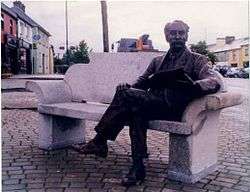Percy French

William Percy French (1 May 1854 – 24 January 1920) was one of Ireland's foremost songwriters and entertainers in his day. In more recent times, he has become recognised for his watercolour paintings as well.
Life
French was born at Cloonyquin House,[1] near Tulsk, County Roscommon, the son of an Anglo-Irish landlord.
He was educated at Foyle College in County Londonderry, and wrote his first successful song while studying at Trinity College Dublin (TCD) in 1877 for a smoking concert. The song, "Abdul Abulbul Amir" was sold for £5 to an unscrupulous publisher. The song later became hugely popular and was falsely claimed by other authors.[2]

He graduated from TCD as a civil engineer in 1881 and joined the Board of Works in County Cavan as an "Inspector of Drains". It is said that he wrote his best songs during this period. He also painted: French was a prolific painter of landscape watercolours and during this period considered art to be his true vocation. In fact, when he became well-known later in his life, his paintings from his time as a civil engineer became fashionable and sought after. When the Board reduced its staff around 1887, French turned to journalism as the editor of The Jarvey, a weekly comic paper.[2] When the paper failed, French's long and successful career as a songwriter and entertainer began. Around this time he married Ethel (Ettie) Kathleen Armitage-Moore (b. 1871), second daughter of William Armytage-Moore, brother of Countess of Annesley, (wife of the Third Earl). But she (and her daughter) died in childbirth at the age of 20.
French became renowned for composing and singing comic songs and gained considerable distinction with such songs as Phil the Fluther's Ball, Slattery's Mounted Foot, and The Mountains of Mourne (this last was one of several written with his friend, stage partner and fellow composer, Houston Collisson).[2]
One of French's most famous songs is "Are Ye Right There Michael", a song ridiculing the state of the rail system in rural County Clare. The song caused such embarrassment to the rail company that it led to a libel action against French, though this ultimately failed. It is said that French arrived late for the libel hearing at the court, and when questioned by the judge on his lateness, he responded "Your honour, I travelled by the West Clare Railway", resulting in the case being thrown out.
French became ill while performing in Glasgow and died some days later (from pneumonia) in Formby, England at the home of his cousin, Canon Richardson of Green Lea, College Avenue, on 24 January 1920, aged 65. His grave is in the churchyard of St. Luke's Parish Church, Formby, Merseyside. A statue of him sitting on a park bench in the town centre of Ballyjamesduff in honour of him and his famous song, "Come Back Paddy Reilly to Ballyjamesduff".
Songs
The following songs are attributed to Percy French:[3]
|
|
Operatic works
Collaborations with William Houston Collisson (1865–1920)
- The Knight of the Road (1891), later known as The Irish Girl (published c. 1918)
- Strongbow (1892)

Art
In recent times, artworks by French have increased in value. On 20 September 2005, the Percy French watercolour "Where ever I go my heart turns back to the County Mayo" was sold by Dublin-based auctioneers Whytes for a then record price of €44,000.[5]
A comprehensive biography of French, focussing on his paintings, Lead Kindly Light, was produced by Oliver Nulty of the Oriel Gallery in 2002.[6] Nulty promoted French from the day he opened the Oriel Gallery in 1968, and he mounted no less than ten solo exhibitions of French and several group shows featuring French. Sir Peter Ustinov opened the 1988 Percy French solo show at the Oriel.
Bibliography
- M. de Burgh Daly: Prose, Poems and Parodies of Percy French (Dublin: Talbot Press, 1929; 3/1962)
- James N. Healy: Percy French and his Songs (Cork: Mercier Press, 1966)
- Brendan O'Dowda: The World of Percy French (Belfast: Blackstaff Press, 1981; 3/1997)
- Alan Tongue: A Picture of Percy French (Belfast: Greystone Books, 1990)
- Oliver Nulty: Lead Kindly Light. Celebrating 150 Years of Percy French (ed. by Bernadette Lowry) (Dublin: Oriel Gallery, 2002)
- Berrie O'Neill: Tones that are Tender: Percy French, 1854–1920 (Dublin: Lilliput Press, 2016)
See also
References
- ↑ "French family at Cloonyquin". Landedestates.ie. 18 May 2011. Retrieved 22 December 2012.
- 1 2 3 De Burgh Daly, Mrs (1973). Prose, Poems and Parodies of Percy French. Dublin: Talbot Press. pp. vii–xv. ISBN 0-85452-107-0.
- ↑ The Songs of Percy French, by James N. Healy (Dublin & Cork: Mercier Press, 1983).
- ↑ "The Emigrant's Letter (Cutting the Corn in Creeslough)". WeLoveDonegal.com. Retrieved 22 December 2012.
- ↑ "Percy French Art". Visual-arts-cork.com. Retrieved 22 December 2012.
- ↑ Nulty (2002), see Bibliography.
External links
| Wikisource has original works written by or about: Percy French |
| Wikimedia Commons has media related to Percy French. |
- The Percy French Summer School, Roscommon
- Example of painting by Percy French
- The Mountains Of Mourne Sweep Down To The Sea – Feature
- Sculpture of Percy French by Alan Hall
- Directions to Percy French's Birthplace